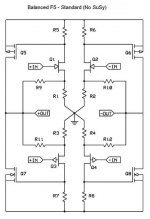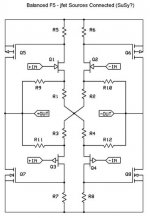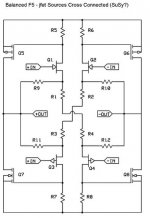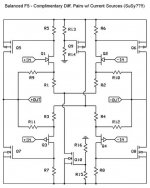I have been nosing around the Pass forum recently trying to decide on a new amp project and have decided on either the U.P. (Chef's UGS based power amp) or a high power balanced F5. While reading through the F5 thread a couple of crumbs were thrown regarding the possibility of a SuSy version of a balanced F5.
Nelson gave this reply about creating a balanced F5:
quote
"
Balanced versions would come in various flavors.
The primary advantage of balanced output operation is more power,
since the push-pull nature of the single-ended version already has
a third harmonic character at higher power levels. Assuming that
you want to maximize the power, the first thing you are likely to do
is to double the number of output devices (2 in parallel), although
this is not essential.
Then you consider whether you simply want to "bridge" the
amplifier by taking to F5 channels and operating them across the
load out-of-phase.
Lastly, assuming that you want an input stage which integrates
what would otherwise be two separate independent input stages,
you have a couple of obvious alternatives.
The most obvious is to simply take the 10 ohm resistors to ground
and connect them to each other instead.
The other is to make an X circuit out of it.
"
unquote
I would like to present a sequence of schematics that I hope result in a proper "X" version of a balanced F5.
While these schematics are all simplified variations of the F5 circuit, I present them as a general example of using SuSy with balanced circuits implementing low impedence feedback. (i.e. I don't want this thread to be just about the F5, it's just the example I'm using.)
Here is a straight forward balanced F5 with no shenanigans:

Great, but no cross coupleing between the halves since the input jfet sources are all tied to ground. That is to say the current through any of the input jfets has no effect on the others
Here is the version with the 10 ohm source resistors (R1-R4) tied together that Nelson talked about:

This version has a nice "X", but Nelson implies in his quote that this is not a SuSy circuit. After careful study, I think this circuit has some potential and might display some SuSy behavior. And I would like to come back to this circuit later (Can you bare the forshadowing?). But let's continue. . .
This is a circuit proposed by EUVL :

This circuit shows an obvious coupling between the halves. And again, through careful study, I believe this circuit operates almost the same as the previous one. In fact, if all the components were truly identical, they would be equivalent. Someone in the F5 thread did some spice analysis and reported both circuits behaved almost identical regarding distortion except the later was more tempermental to part matching. But, that is somewhat off the subject; if the circuits are equivalent and one isn't X, then neither is the other.
Which made me think about what makes my 100w AX clones an "X" circuit. It is because the input is a differential pair which transfers the error feedback from one side of the amp as an error current between the sources of the input pair. And therfore causes the same error to reproduce itself in-phase on the other side.
So make the inputs differential pairs:

This circuit has got to be SuSy. It's practically the Susy patent circuit but with source feedback in a complimentary topology. The circuit is somewhat less elegant than what I had imagined, it looks like something from my microcircuits textbook. But elegant or not, I believe whole heartedly this is a SuSy circuit.
Which got me thinking back to the circuit with all the sources connected (the one with the foreshadowing). While there may not be a current source per-se nor obvious differential pairs: The n-jfets through a kind of differential action create a virtual current source for the p-jfets, and the p-jfets do the same for the n-jfets. Another way to look at is: the current through R1 and R2 must equal the current thorugh R3 and R4. Therefore, I think this circuit does have a susy character, but with susy performance declining as the jfet matching gets worse (i.e. resulting in a less constant current through R1 and R2 together (as well as R3 and R4 together).
I think Nelson was trying to throw us off track when he said, "The most obvious is to simply take the 10 ohm resistors to ground
and connect them to each other instead.
The other is to make an X circuit out of it."
I think to "simply take the 10 ohm resistors to ground
and connect them to each other instead" does create an X circuit, he was just waiting for someone to call him out.
What do you think?
Jeez, sorry about the long post, but when you're on a roll. . .
Nelson gave this reply about creating a balanced F5:
quote
"
Balanced versions would come in various flavors.
The primary advantage of balanced output operation is more power,
since the push-pull nature of the single-ended version already has
a third harmonic character at higher power levels. Assuming that
you want to maximize the power, the first thing you are likely to do
is to double the number of output devices (2 in parallel), although
this is not essential.
Then you consider whether you simply want to "bridge" the
amplifier by taking to F5 channels and operating them across the
load out-of-phase.
Lastly, assuming that you want an input stage which integrates
what would otherwise be two separate independent input stages,
you have a couple of obvious alternatives.
The most obvious is to simply take the 10 ohm resistors to ground
and connect them to each other instead.
The other is to make an X circuit out of it.
"
unquote
I would like to present a sequence of schematics that I hope result in a proper "X" version of a balanced F5.
While these schematics are all simplified variations of the F5 circuit, I present them as a general example of using SuSy with balanced circuits implementing low impedence feedback. (i.e. I don't want this thread to be just about the F5, it's just the example I'm using.)
Here is a straight forward balanced F5 with no shenanigans:

Great, but no cross coupleing between the halves since the input jfet sources are all tied to ground. That is to say the current through any of the input jfets has no effect on the others
Here is the version with the 10 ohm source resistors (R1-R4) tied together that Nelson talked about:

This version has a nice "X", but Nelson implies in his quote that this is not a SuSy circuit. After careful study, I think this circuit has some potential and might display some SuSy behavior. And I would like to come back to this circuit later (Can you bare the forshadowing?). But let's continue. . .
This is a circuit proposed by EUVL :

This circuit shows an obvious coupling between the halves. And again, through careful study, I believe this circuit operates almost the same as the previous one. In fact, if all the components were truly identical, they would be equivalent. Someone in the F5 thread did some spice analysis and reported both circuits behaved almost identical regarding distortion except the later was more tempermental to part matching. But, that is somewhat off the subject; if the circuits are equivalent and one isn't X, then neither is the other.
Which made me think about what makes my 100w AX clones an "X" circuit. It is because the input is a differential pair which transfers the error feedback from one side of the amp as an error current between the sources of the input pair. And therfore causes the same error to reproduce itself in-phase on the other side.
So make the inputs differential pairs:

This circuit has got to be SuSy. It's practically the Susy patent circuit but with source feedback in a complimentary topology. The circuit is somewhat less elegant than what I had imagined, it looks like something from my microcircuits textbook. But elegant or not, I believe whole heartedly this is a SuSy circuit.
Which got me thinking back to the circuit with all the sources connected (the one with the foreshadowing). While there may not be a current source per-se nor obvious differential pairs: The n-jfets through a kind of differential action create a virtual current source for the p-jfets, and the p-jfets do the same for the n-jfets. Another way to look at is: the current through R1 and R2 must equal the current thorugh R3 and R4. Therefore, I think this circuit does have a susy character, but with susy performance declining as the jfet matching gets worse (i.e. resulting in a less constant current through R1 and R2 together (as well as R3 and R4 together).
I think Nelson was trying to throw us off track when he said, "The most obvious is to simply take the 10 ohm resistors to ground
and connect them to each other instead.
The other is to make an X circuit out of it."
I think to "simply take the 10 ohm resistors to ground
and connect them to each other instead" does create an X circuit, he was just waiting for someone to call him out.
What do you think?
Jeez, sorry about the long post, but when you're on a roll. . .
I think your gravitating toward the John Curl complimentary dual diff circuit or whatever he calls it (currently used in the Blowtourch). I'm not sure Nelson would want to suggest that 
But, it is a good simple circuit and I've been wanting to build one myself. John insists that it is too difficult for us DIYers to do. I think because to be done right, you need to mach Idss, transconductance, Vth and who knows what else. That would take a population of thousands of devices to get 4 good enough
But, it is a good simple circuit and I've been wanting to build one myself. John insists that it is too difficult for us DIYers to do. I think because to be done right, you need to mach Idss, transconductance, Vth and who knows what else. That would take a population of thousands of devices to get 4 good enough
You have the right idea, but there is a flaw which I ran into
many years ago. The low impedance of the Sources of the
JFETs soak up error signal, leaving only a fraction of it left
for transmission to the other half of the circuit, so you only
get a little bit of the cancellation.

many years ago. The low impedance of the Sources of the
JFETs soak up error signal, leaving only a fraction of it left
for transmission to the other half of the circuit, so you only
get a little bit of the cancellation.
I think your gravitating toward the John Curl complimentary dual diff circuit or whatever he calls it (currently used in the Blowtorch).
The Blowtorch uses a folded cascode. If we grant John that
rendering it with the perfection that only he can achieve,
that still leaves you with the opportunity to make something
similar and possibly quite satisfying.
- Status
- This old topic is closed. If you want to reopen this topic, contact a moderator using the "Report Post" button.